
Stars: Alioth (ε Ursae Majoris), Alkaid (η Ursae Majoris), Alnasl (γ Sagittarii), Altair, Al Niyat (τ Scorpii), Al Niyat (σ Scorpii), Antares (α Scorpii), ψ Aqr, ψ1 Aqr, ψ2 Aqr, ψ3 Aqr, ω1 Aqr, ω2 Aqr, 104 Aqr, b1 Aqr, b2 Aqr, c2 Aqr, Tau2 Aqr, Arcturus (α Boötis), Ascellla (ζ Sagittarii), Cebalrai (β Oph), ε CrA, γ CrA, α CrA (Alphekka Meridiana), β CrA, δ CrA, λ CrA, ζ CrA, Deneb, Dschubba, Graffias,Fomalhaut (α Piscis Austrini), Hecatebolus (τ Sagittarii), Hydor, Kaus Australis (ε Sagittarii), Kaus Borealis (λ Sagittarii), Kaus Medii (δ Sagittarii), Mizar (ζ Ursae Majoris)-Alcor, Nanto (φ Sagittarii), Nunki (σ Sagittarii), 30 Oph, Skat, Vega, V686 CrA, V2314 Oph, V2323 Oph, V2386 Oph.
HR Stars: 6248, 6670
HD Stars: 150935, 150859, 151091, 151258, 152484, 152555, 152600, 153240, 153437, 152210, 161184, 161185, 161242, 161480, 161542, 161622, 161867
Asterisms: Coathanger/Brocchi’s Cluster/Cr 399, DAVe, Keystone of Hercules, Taurus Poniatovskii, Teapot
Constellations: Ophiuchus, Pisces Austrinus
Nebula: Dark Horse Nebula, Pipe Nebula
Index Catalogue (IC): 4665
Planets: Saturn
Moon
Located, but not Observed: Aquila, Capricornus, Cygnus, Delphinus, M4, Sagitta, Serpens Caput, Serpens Cauda
Messier Objects: M6 (Ptolemy's Cluster), M7 (Butterfly Cluster), M10, M11 (Wild Duck Cluster / NGC 6705), M12, M13 (Hercules Cluster)
Location: Site 15, Kejimkujik National Park & National Historic Site
Date: 2024-10-03
Time: 6:40 PM – 11:30 PM ADT
Equipment: Visual, Binoculars
Seeing: Very Good (2)
Transparency: Good (3)
| Time (PM ADT) |
SQM | Temp (° C) |
| 8:30 | 21.39 | 17 |
| 8:49 | 21.33 | 15 |
| 9:14 | 21.44 | 13 |
| 9:50 | 21.47 | 13 |
| 10:30 | 21.43 | 13 |
| 10:56 | 21.44 | 12 |
After a cloudy night we woke to sunshine and calm waters. A Fox Sparrow greeted us, even came within 6' and stared at me before deciding it wasn't safe to get closer so dashed away. The squirrels carried on as per usual with their shenanigans.
Following a scrambled egg with bacon, toast, coffee, and strawberry-banana-with-yoghurt breakfast, we decided to go for a paddle on the calm Kejimkujik Lake waters. We left our site and headed south towards a small unnamed island adjacent to The Sisters before heading back north between Big Muise and Little Muise Island. It was here that I named a large glacial erratic as the Space Shuttle because it reminded me of the shuttle's nosecone. While paddling, we reminisced about the October 4-6, 2021 Star Party we enjoyed with the Chapmans - similar calm waters and such clear skies.
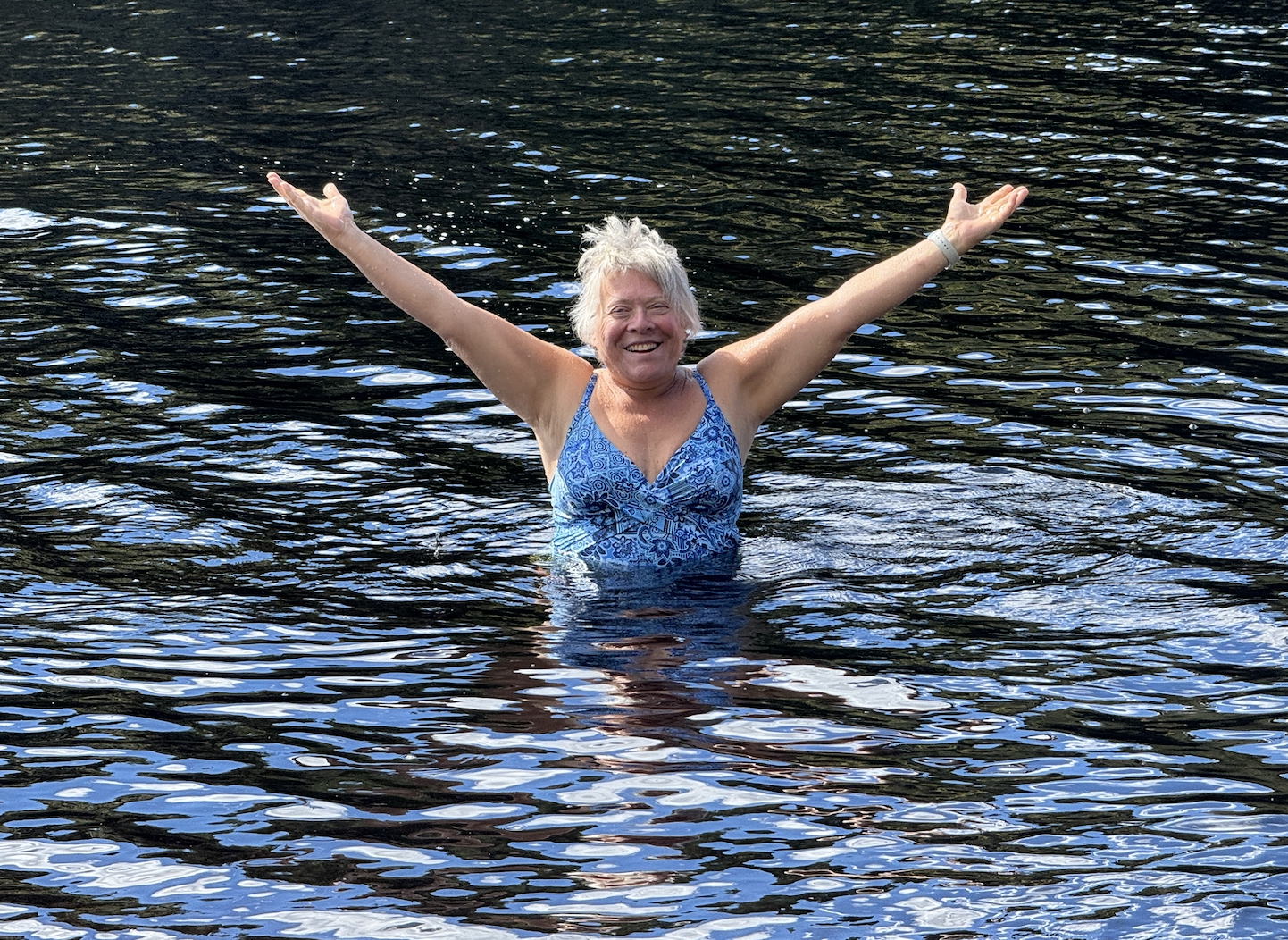
|
Following our corned beef on rye sandwich lunch, we moved on to our next adventure - a swim in the not-so-warm Kejimkujik Lake! Did I mention it was COLD!! Too cold for me to go for a swim (which isn't like me not to go for a swim). Thankfully, after quickly getting wet, it was back to the beach to let our bodies warm up in the afternoon Sun. Even had some time for reading before dinner. While Jerry walked to the north point to determine the best location to view the sunset, I witnessed a Bald Eagle fly in a circle twice in front of me before diving to catch a fish. Wow. First time I have ever seen an Eagle here. |
|
At 6:40 PM, we walked north on the stone beach to the island's point so that we could witness the sunset. Hoped to also see Mercury and the waxing Crescent Moon as the Sun set but clouds on the horizon prevented seeing either one. I took photos and Jerry took video. Beautiful colours. As the skies darkened, Arcturus became visible. Loons provided a brief serenade to our south at 6:48 PM. Shortly after, we headed back to the campsite for an evening under the stars. There was a threat of smoke that would affect the transparency later in the evening. Fingers crossed it wouldn't be significant. |
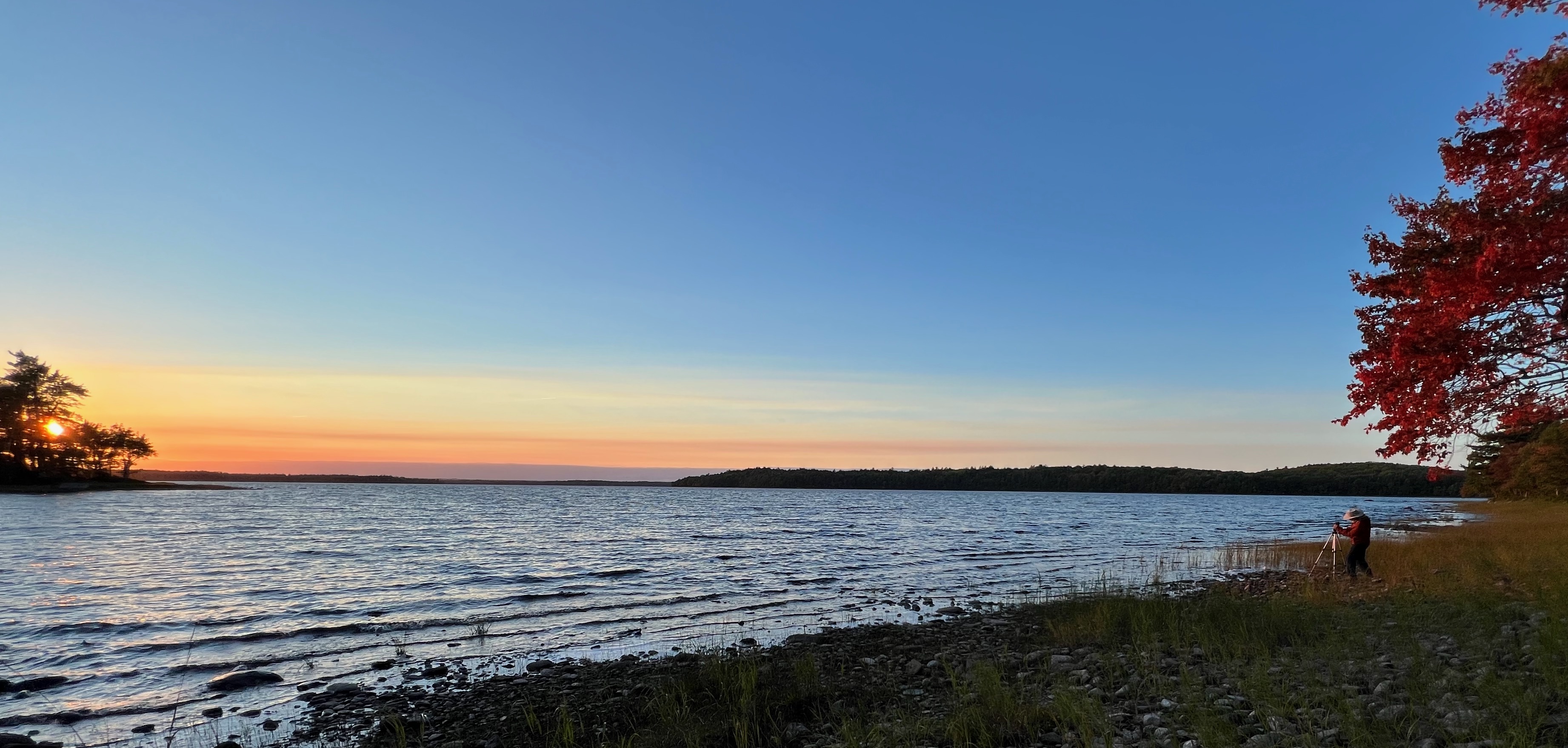
|
Towards the north, the three stars of the Dipper handle (Alioth, Mizar and its less bright partner Alcor), Alkaid) were visible above the tree line. Above our heads, the bright stars forming the asterism DAVe (Deneb, Altair, Vega) shone brightly.
|
The 8 stars in the Teapot asterism were visible, including Kaus Media that wasn't seen last evening. And there was Corona Australis (CrA) south of it! With pencil and sketch pad, I began sketching the constellation's arc - ε CrA and two adjacent stars, γ CrA, α CrA (Alphekka Meridiana), β CrA, δ CrA and ζ CrA. I could also see V686 CrA and λ CrA that, according to the charts, were not part of the Corona. Three stars in the southern portion of the constellation were clouded over - θ CrA that was part of the Corona along with those that were not (V681, η1, and η2). One goal of the trip reached! |
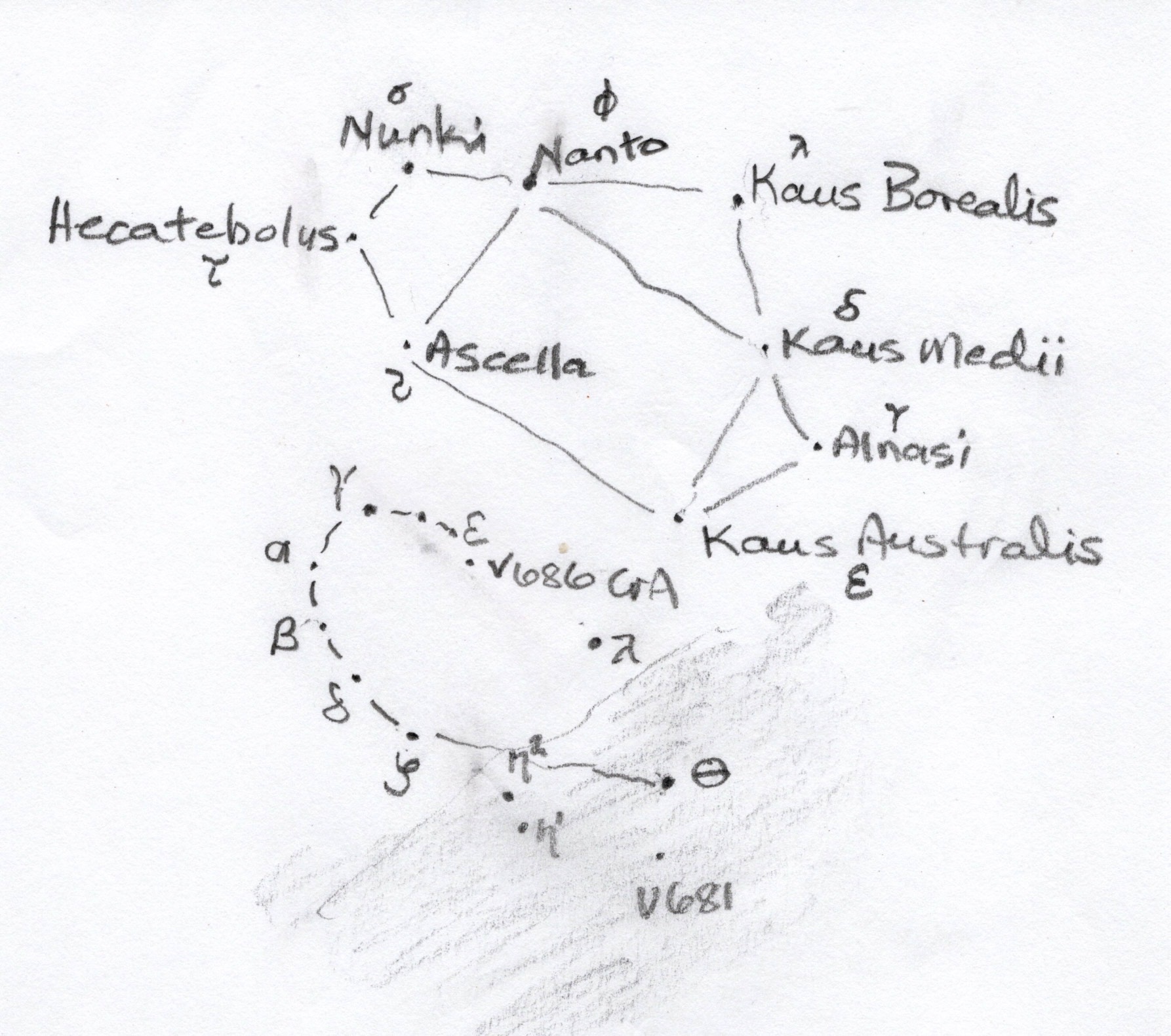
|
|
While the Teapot was above the horizon, I followed the line out from Ascella to Kaus Australis to look for M7 (Ptolemy's Cluster) and the smaller M6 (Butterfly Cluster). It took a while to locate them because of the slight haze but they were both found. M7 is still one of my favourite open clusters. So beautiful. Red Antares was located in Scorpius, as were Al Niyat (τ Scorpii), Al Niyat (σ Scorpii), Dschubba and Graffias. It wasn't dark enough yet to see M4 even though Scorpius was just high enough above the trees to locate it; the remainder of the claws and the body were hidden in the trees. By the time it was dark enough, M4 was below the tree line. |
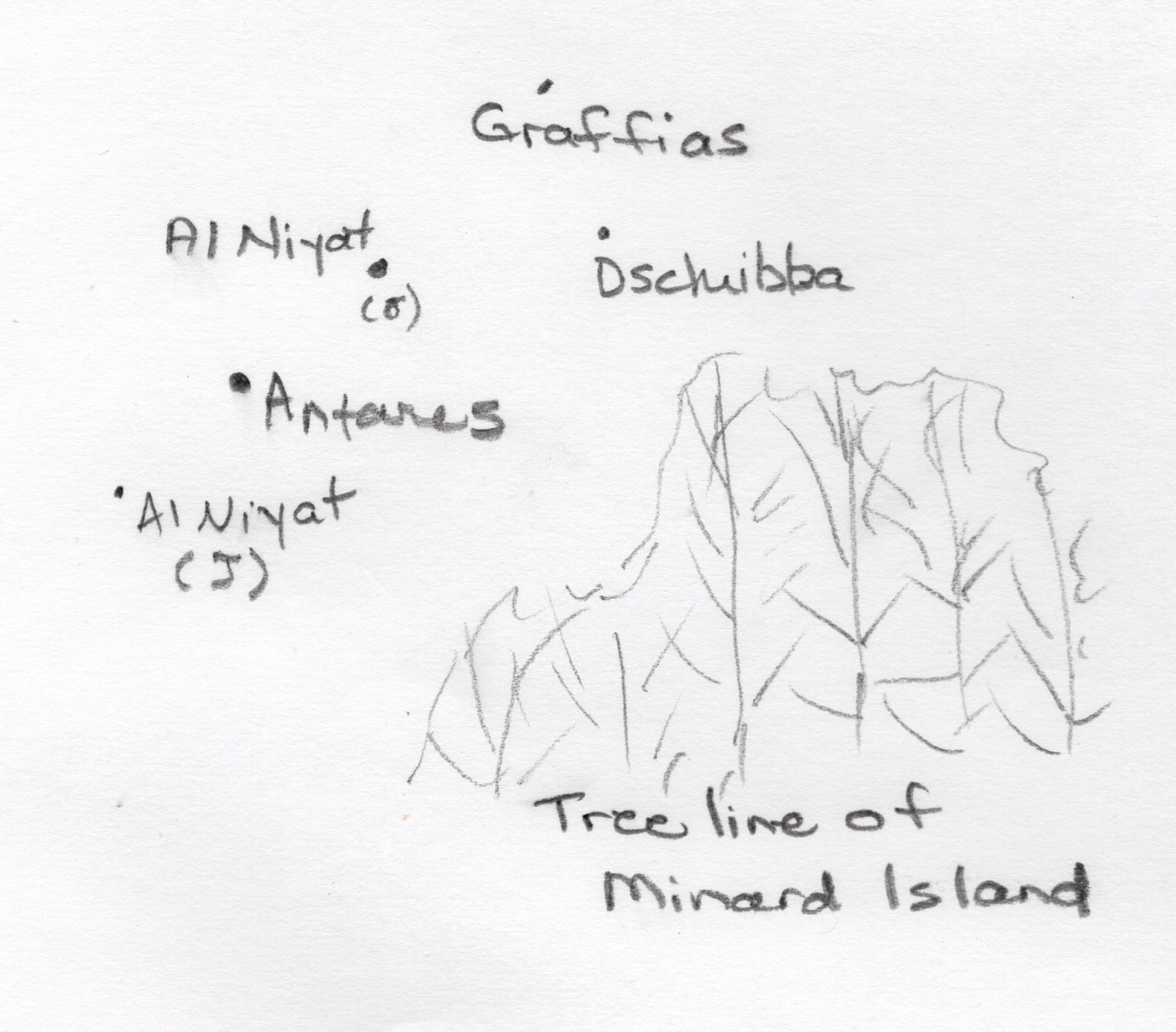
|
I knew I could not observe the structure of M10 and M12 with binoculars but decided to sketch the starfield around them. What was interesting was the rectangle of stars seen northeast of M12 that I could not identify in SkySafariPro; they were so evident in the binoculars but not so in the app. But there was a group of four stars to the west that formed an elongated "T" that I could identify. Two stars between them - HD152210 and HR 6248 - were angled.
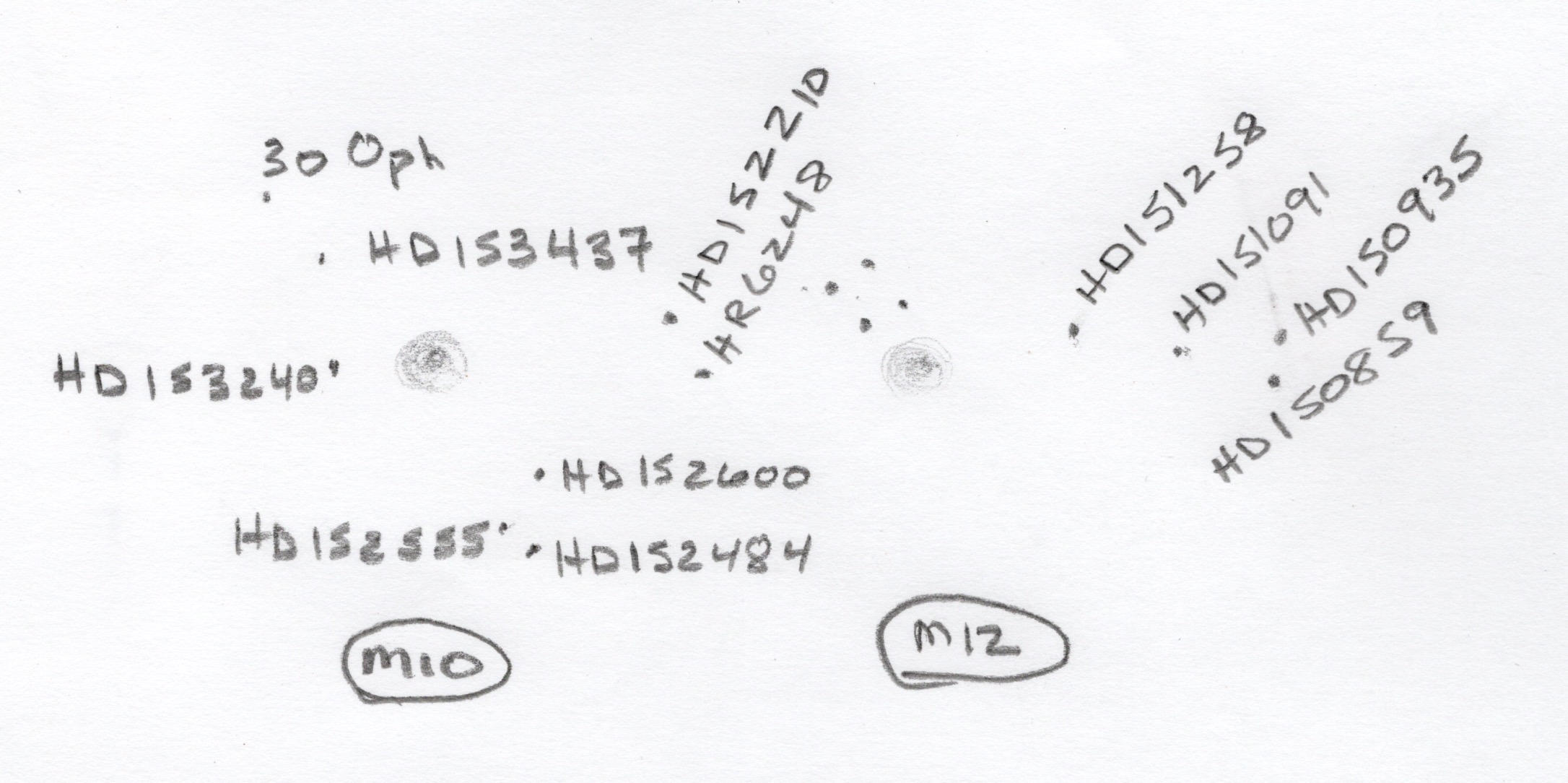
|
I stared at Ophiuchus for a bit afterwards at the area above Cebalrai (β Oph). The cluster above the eastern shoulder had caught my eye earlier in the evening. First, I visually confirmed it was Ophiuchus and that the line of stars angled towards the east were those of Serpens Cauda. After a few attempts to find Cebalrai with my binoculars, I found it then saw several stars above it; no nebulosity was seen around them. There appeared to be three rows of stars - one pair seemingly parallel to each other and the third angled away from it. HR6670 was almost as bright as Cebalrai! SkySafariPro identified the cluster as IC 4665 / Collinder 349 / Melotte 179. I found it interesting that the cluster was so clearly visible between Ophiuchus and Serpens Cauda. Once home and confirming the ID of stars in its centre, I came to realize that what I was looking at was the now defunct constellation Taurus Poniatovii (Poniatowki's Bull). Dave Chapman had pointed me to this "little bull" in 2022 and here I am "rediscovering" it two years later! So exciting! Cosmicpursuits.com described it: "[The inner stars] form the pattern of the word “HI”, like a big friendly cosmic greeting." |
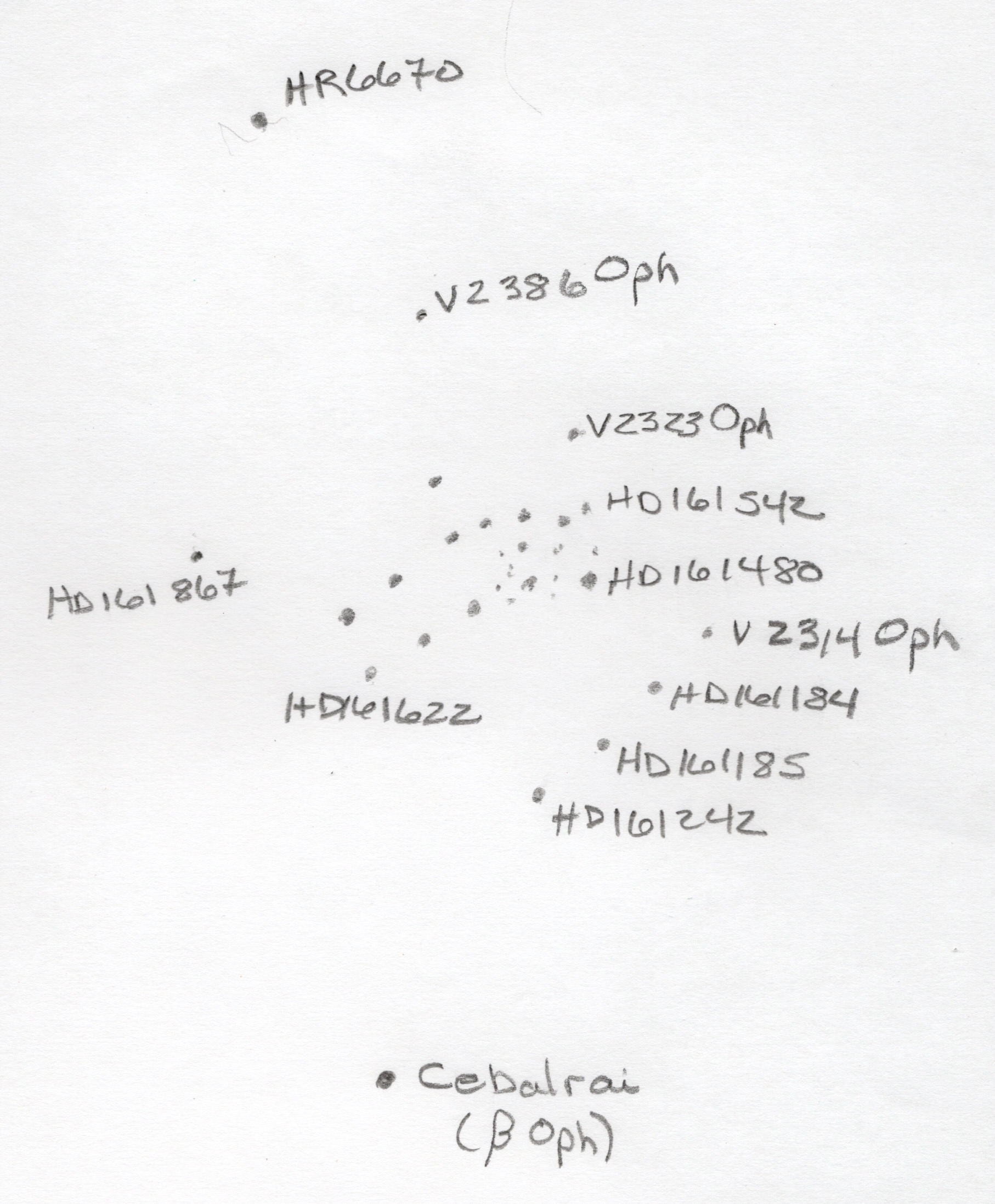
|
Looking westward, I followed the zigzag line of stars forming Serpens Caput (the head of the snake). Looking further north almost to the zenith was the Keystone of Hercules. I used binoculars to find M13 and was it ever bright! When Jerry found it, he thought it was another star!
At one point, Jerry was trying to locate and capture the Dark Horse Nebula. It was lower in the sky at that point and not as dark as we usually see it. I informed him it was comprised of many elements - the Pipe Nebula (bowl of the pipe forming the horse's hip and the stem serving as a rear leg), plus many Barnard's Nebulae (Barnard 63 forming its bent front leg with the head and torso formed by 67a, 72, 75, 261, 262, 266, 269 and 396.) Who knew we were looking at numerous dark nebulae all these years?
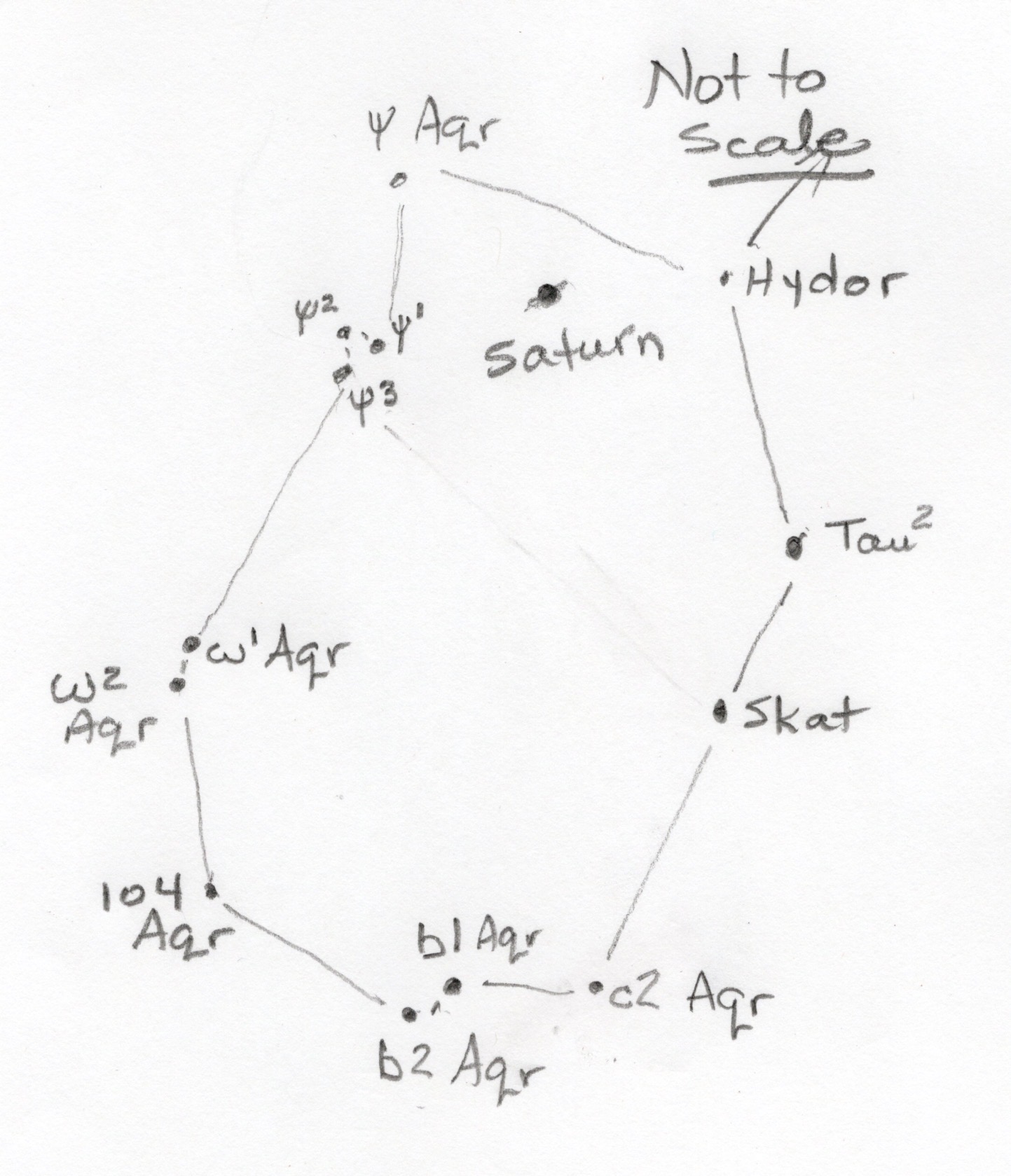
|
While examining the Milky Way, I recognized the Scutum Star Cloud, so easily located M11 / Wild Duck Cluster / NGC 6705 in my binoculars. I showed Jerry where to look and to imagine a golf club head adjacent to a fuzzy golf ball. We then began looking eastward once more. Fomalhaut (α Pisces Austrini) had just come past the trees of the south shore of our island. The other stars in Pisces Austrinus were also visible above the horizon but I did not specifically identify them. Above Pisces Austrinus was a very bright entity - Saturn. In binoculars, it was an ellipsis only; the magnification of 10x42 Binoculars didn't allow for much else. SkySafariPro showed the planet was in Aquarius. This prompted me to identify and sketch the stars surrounding the planet. |
It was at this point that I looked for the asterism DAVe again. Visually going up 1/3 of the way between Altair and Vega, I stared at a point and when I put up my binoculars there was the Coathanger / Brocchi's Cluster / Cr 399. It was now 11:30 PM and the haziness/murk at the horizon was increasing as were the threat of clouds in the west. Bedtime.
| We woke up at 7:30 AM to welcome another beautiful sunny day with mirror-like waters. After breakfast, we packed up and headed once more out onto the Lake. It was such a beautiful day that we decided to do some leisurely touring. We paddled past the group campsite on Ritchie Island to head south towards the eastern isthmus of Little Muise Island to determine if there was a suitable place that faced south for astronomy equipment, then turned to head north again. At the north point of Ritchie Island, we were curious about a small structure we saw; we paddled to it to discover it was an inuksuk. This was not appropriate for this Park (it was reported before we left the Park). Headed north to the Mersey River to unload the canoe, loaded the car, and headed home. |
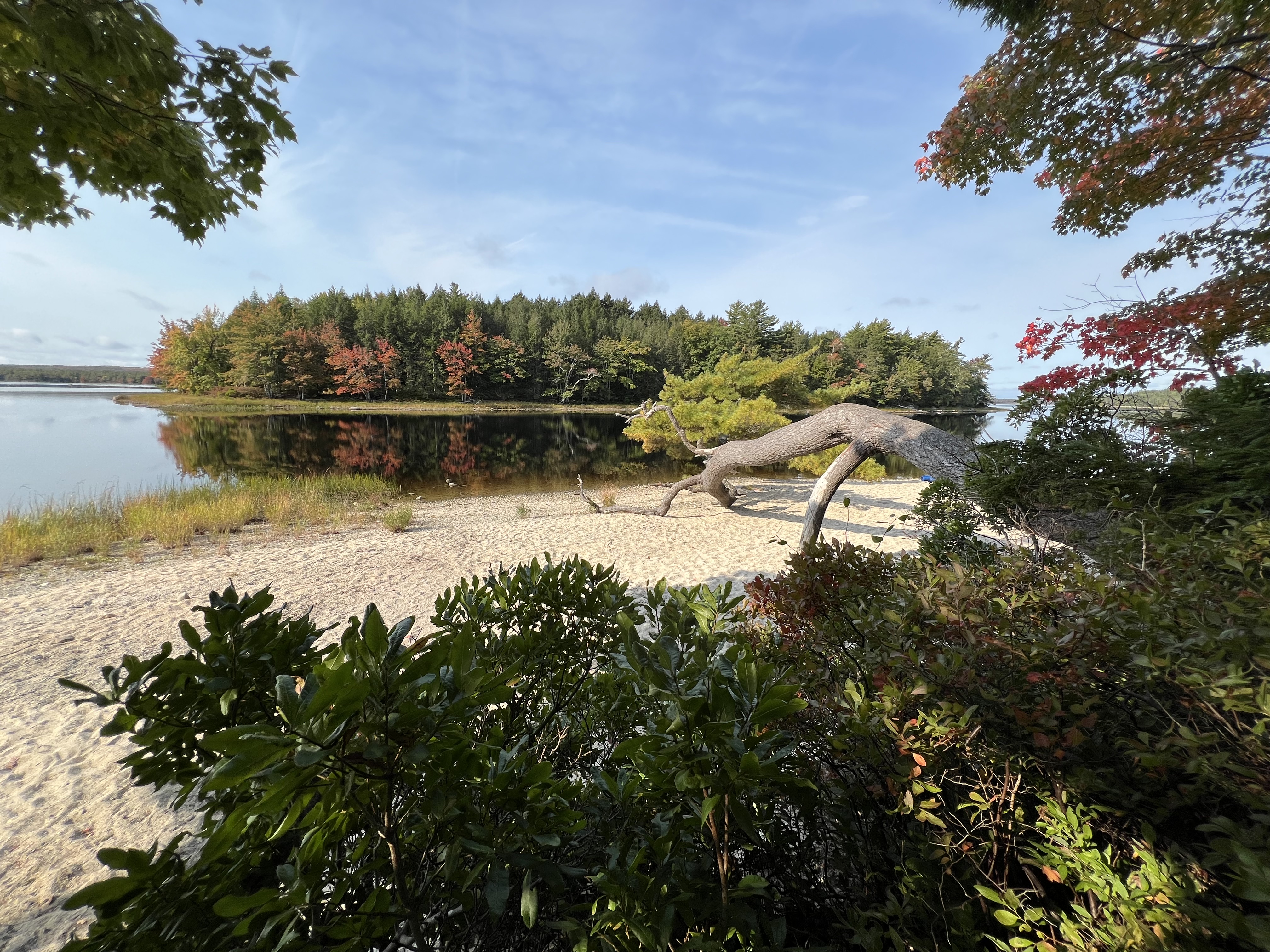
|
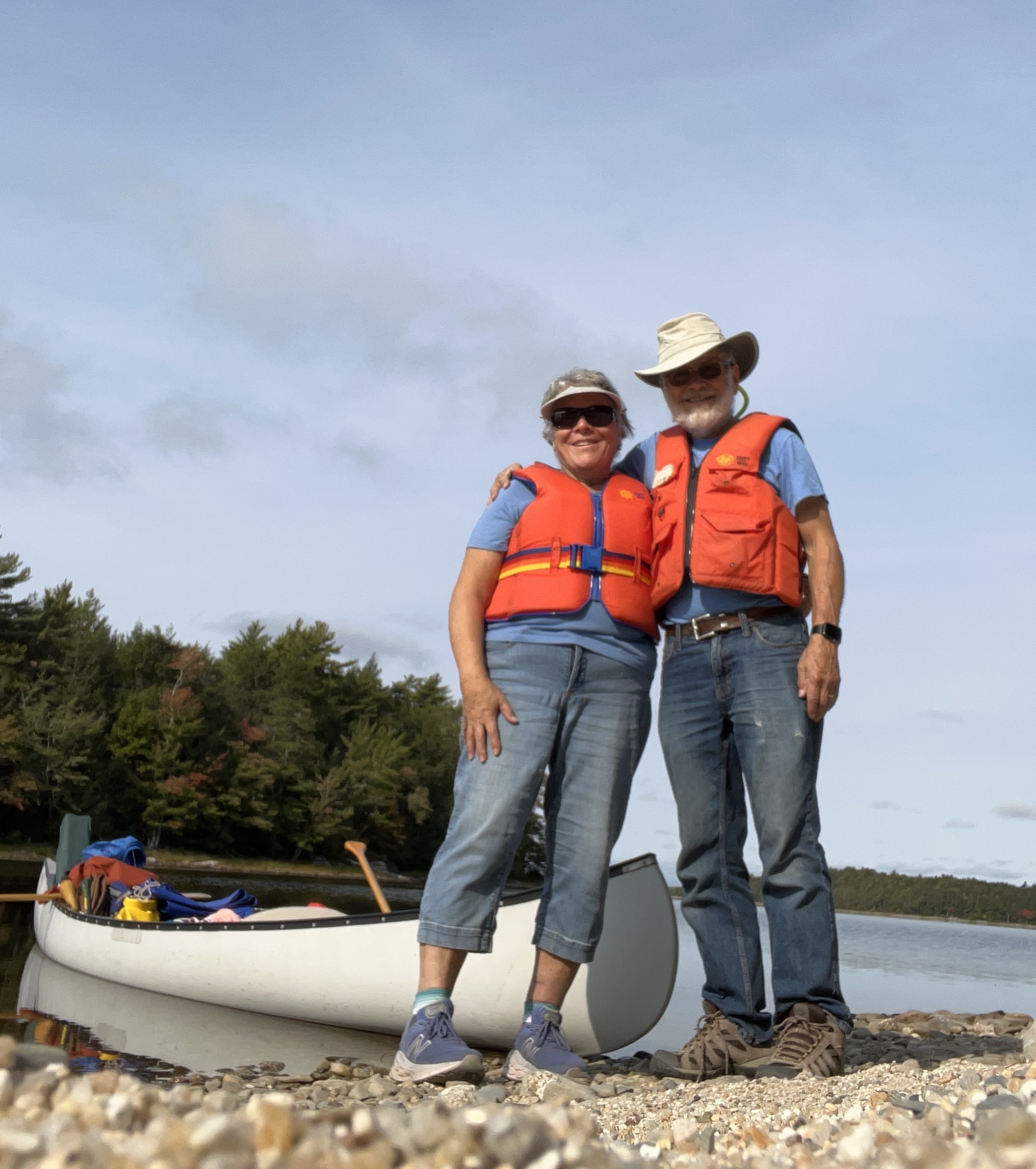
|
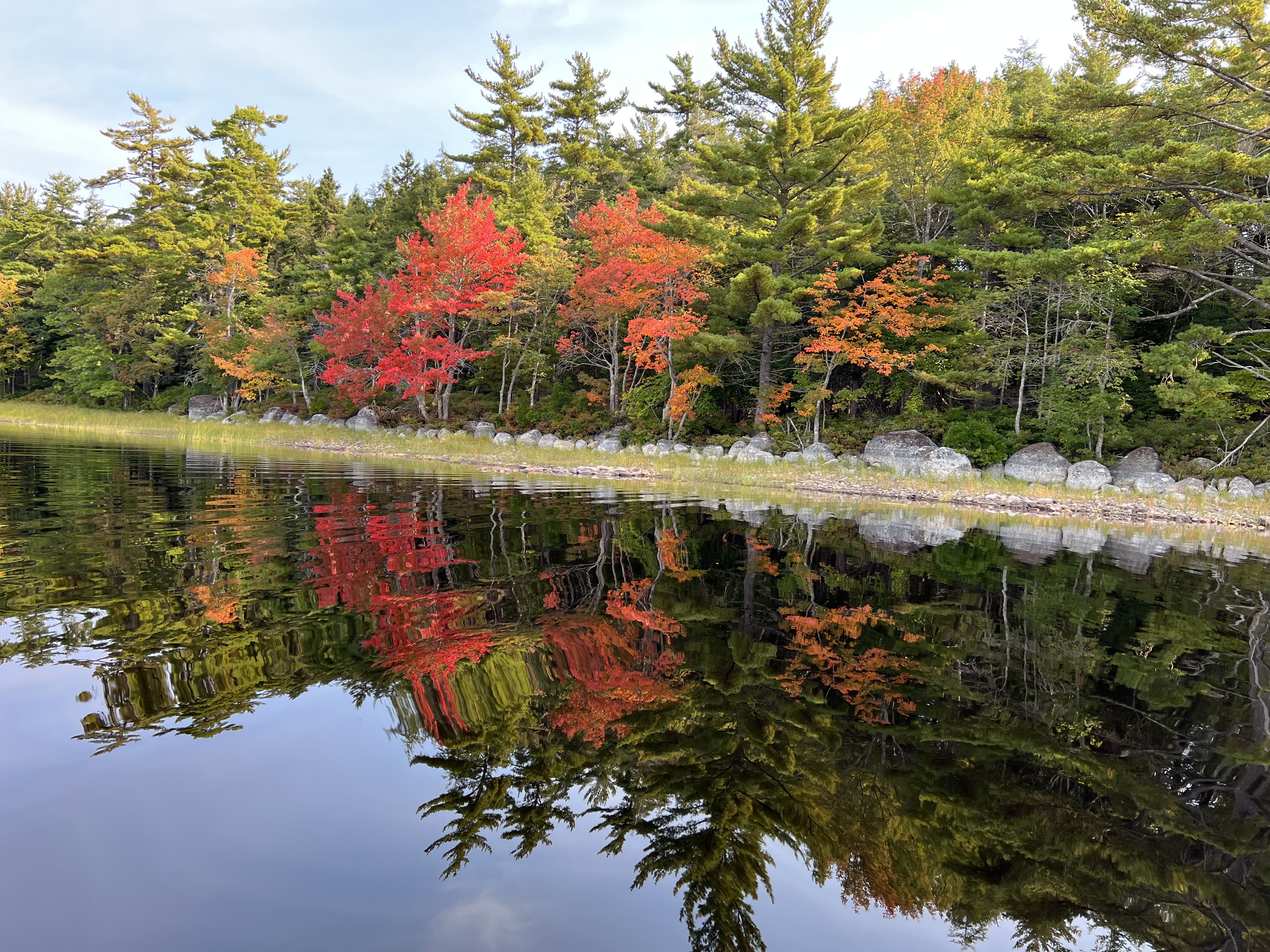
|
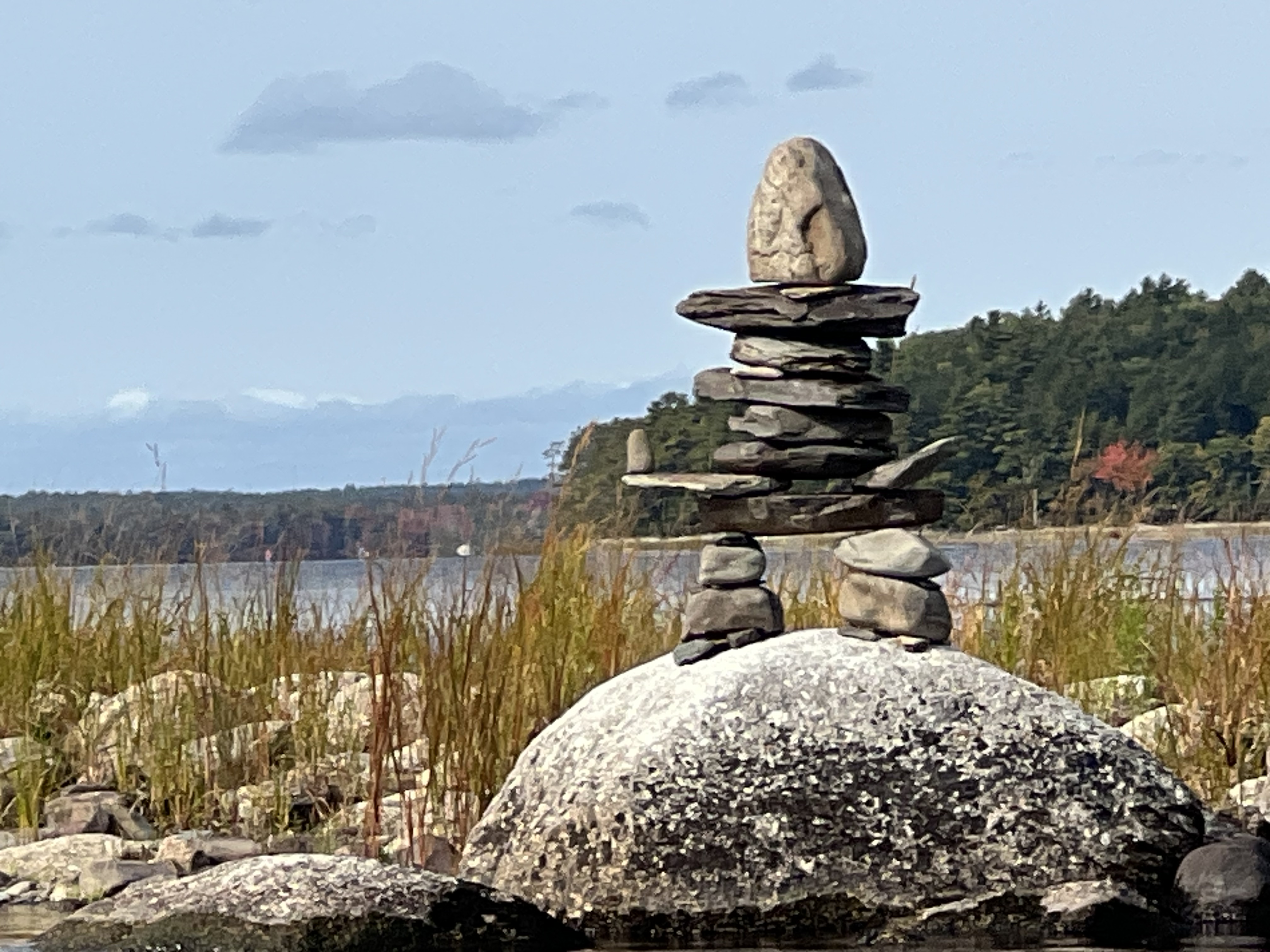
|